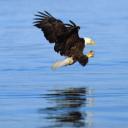Yahoo Answers is shutting down on May 4th, 2021 (Eastern Time) and beginning April 20th, 2021 (Eastern Time) the Yahoo Answers website will be in read-only mode. There will be no changes to other Yahoo properties or services, or your Yahoo account. You can find more information about the Yahoo Answers shutdown and how to download your data on this help page.
Trending News
Are Alaskan Eskimos that of Mongolian descendant?
I see some similarities between Mongols and Native Alaskan peoples (inuits). They are kind-of like Native Americans, in-fact, they are Native Americans. All throughout the Yukon Territory these peoples live here. However, I know that the Bering Straight was in theory where the Native American Indian tribes came across to get from the Polar regions as far south as Chile. So, with this said, are Alaskan Eskimos and inuits that of Mongolian descendants?
6 Answers
- Ghost of societyLv 610 years ago
The people that you are talking about are the Eskimo people and one person that I know who is Eskimo said that their people do have stories of using the land bridge. The native American/first nations/Alaskan Indians do not have stories of coming across the land bridge. They do in fact share a similar story that pretty much say that our peoples have always been here. Any of us talk of that...some people will say that it comes from some religion that we belong to...I do not know what they are talking about when they say that. It is too much of a coincidence that different tribes share a similar story about always being here. I forgot others say that there have been no remains found to prove that story of always being here and I say that would be suggesting that all the lands in America and Canada have been searched thoroughly.
If you were to take an Eskimo and compared them side by side with a first nations, native American, Alaskan Indian...you would see they do not look the same. One would have to be blind to not see a difference.
Here is a link that talks about native Americans being more related to each other than being related to Asians. It does talk about those who are the Eskimo people in Alaska. The Eskimo people really do resemble Asians.
http://www.sciencedaily.com/releases/2009/04/09042...
With what this links says I would say that the Eskimo people are the ones that have Asian relatives. I wouldn't say Mongolian but I would say Asian.
The Athabascan Indian tribe from Alaska and Canada share a language similarity with the Navajo language and Apache language. The Tlingit a tribe that is from the Athbascan share a language similarity as well and the Tlingit are also in Alaska and Canada. When you think about that that is a lot of miles between the tribes in Alaska/Canada and the tribes that are in the states.
Alaska does have two other Indian tribes called the Tsimshian and the Haida they are also in Canada as well. I do not know if the Tsimshian or Haida share a language similarity with other tribes elsewhere like the other Indian tribes previously mentioned
- 5 years ago
Yes and No. The Native Americans is a broad term. Native Americans refer to the Mongloids that came through the Baring Straight as well as the ones that Migrated from the Islands and south America. This was most likely the reason for warring tribes because it was two kids of people coming into the lands. One from Afro ***** Decent and the other from Asiatic Mongoloid.
- Anonymous10 years ago
It seems they are.
It is possible that during the ICE age, these people of Mongolian heritage were able to travel from Asia to the Americas by walking across the frozen Pacific Ocean.
- How do you think about the answers? You can sign in to vote the answer.
- gee beeLv 710 years ago
The term "Mongoloid" comes from the Mongol people of East Asia, who invaded much of Eurasia during the 13th century, establishing the Mongol Empire. The first usage of the term Mongolian race was by Christoph Meiners in a "binary racial scheme" of "two races", with the Caucasian whose racial purity was exemplified by the "venerated... ancient Germans" and "Mongolians" who consisted of everyone else.
Johann Blumenbach said he borrowed the term Mongolian from Christoph Meiners to describe the race he designated "second, [which] includes that part of Asia beyond the Ganges and below the river Amoor [Amur], which looks toward the south, together with the islands and the greater part of these countries which is now called Australian".
In 1861, Isidore Geoffroy Saint-Hilaire added the "Australian" as a "secondary race" (subrace) of the "principal race" of "Mongolian". In the nineteenth century Georges Cuvier used the term Mongolian again as a racial classification, but additionally included American Indians under the term. Arthur de Gobineau defined the extent of the "Mongolian" race, "by the yellow the Altaic, Mongol, Finnish and Tartar branches." Later, Thomas Huxley used the term Mongoloid and included American Indians as well as Arctic Native Americans. Other nomenclatures were proposed, such as Mesochroi (middle color), but Mongoloid was widely adopted.
In 1882, Irish anthropologist Augustus Henry Keane who was professor at University College, London, said the "Mongolic type" included the following "races": "Tibetans", "Burmese", "Tai", "Koreans", "Japanese", "Lu-Chu", "Finno-Tatars" and "Malays". Keane said the following peoples are "mixed Mongolo-Caucasic varieties": "Anatolian Turks", "Uzbegs", and "Tajiks of Turkestan". Keane said the "Kazaks" are "intermediate" between the "Túrki" and "Mongolian" races.[13] Keane said the "Mongolian race" is "best represented" by the "Buriats".
In 1940, anthropologist Franz Boas included the "American race" as part of the "Mongoloid race" of which he mentioned the "Aztecs of Mexico" and the "Maya of Yucatan".[14] Boas also said that, out of the "races of the Old World", the "American native" had features most similar to the "east Asiatic".
In 1983, Douglas J. Futuyma, professor of evolutionary processes at the University of Michigan, said that the inclusion of Native Americans and Pacific Islanders under the Mongoloid race was not recognized by "many anthropologists" who consider them "distinct races".
In 1984, Roger J. Lederer Professor of Biological Sciences at the California State University at Chico, separately listed the "Mongoloid" race from Pacific islanders and American Indians when he enumerated the "geographical variants of the same species known as races... we recognize several races Inuit, American Indians, Mongoloid... Polynesian".
In 1998, Jack D. Forbes, professor of Native American Studies and Anthropology at the University of California, Davis, said that the racial type of the indigenous people of the Americas "does not fall into" the "Mongoloid" racial category. Forbes said that due to the various physical traits indigenous Americans exhibit, some with "head shapes which seem hardly distinct from many Europeans", indigenous Americans must have either been formed from a mixture of "Mongoloid" and "Caucasoid" races or they descend from the ancestral, common type of both "Mongoloid" and "Caucasoid" races.
Source(s): google and wiki - Sweetdaddy RexLv 710 years ago
Yes, and other Asian races; At one time, there was a strip of land connecting what is now Siberia, and N. America !





